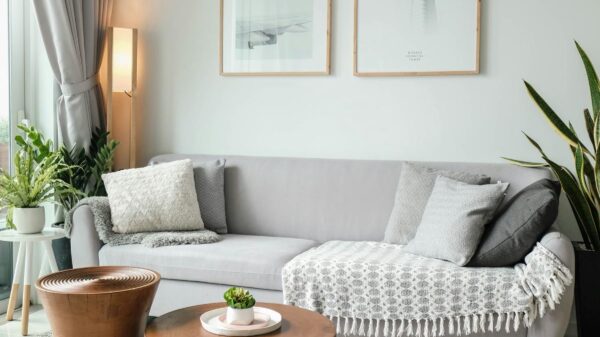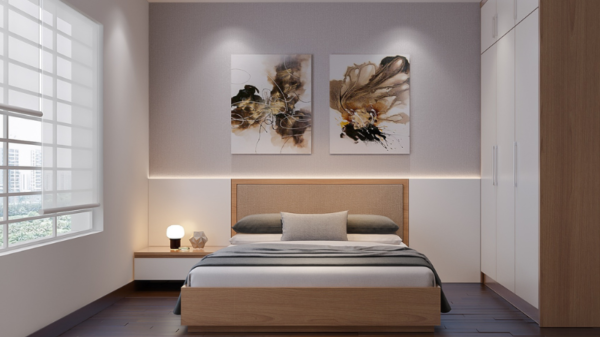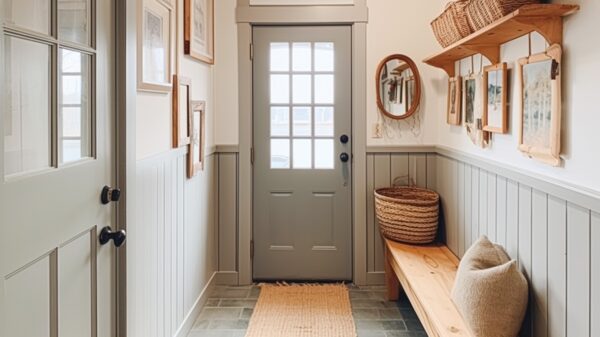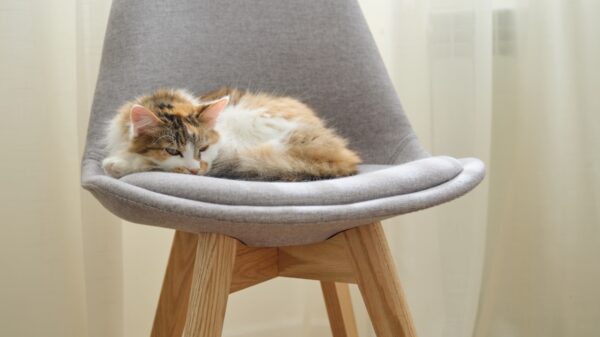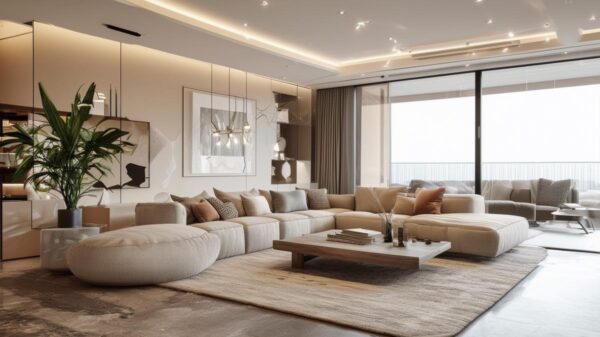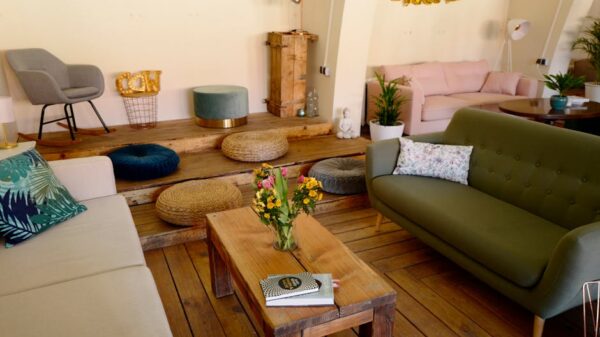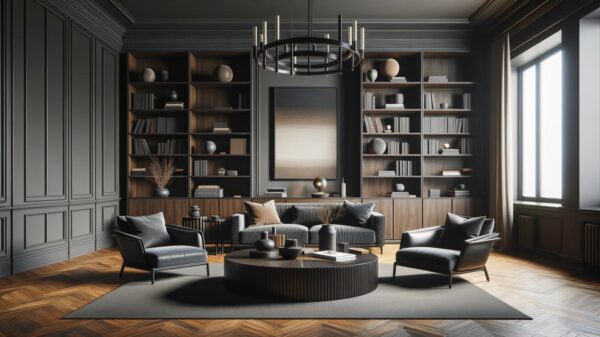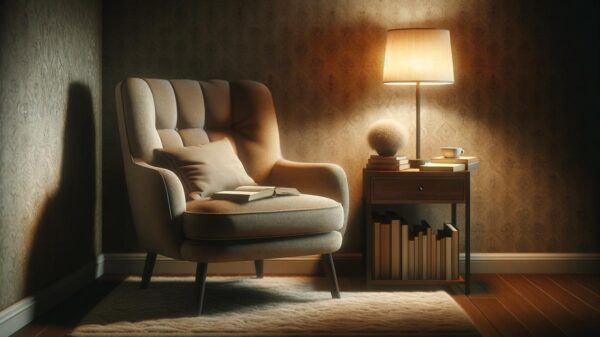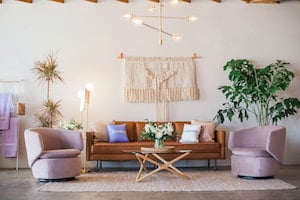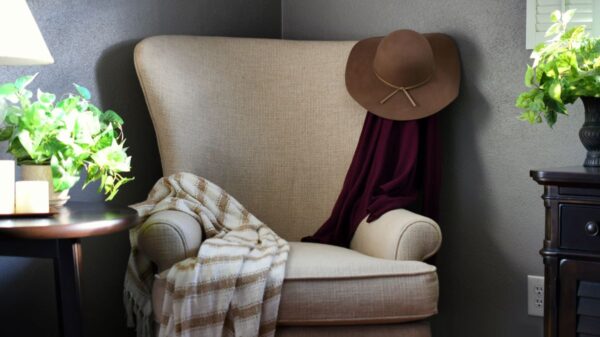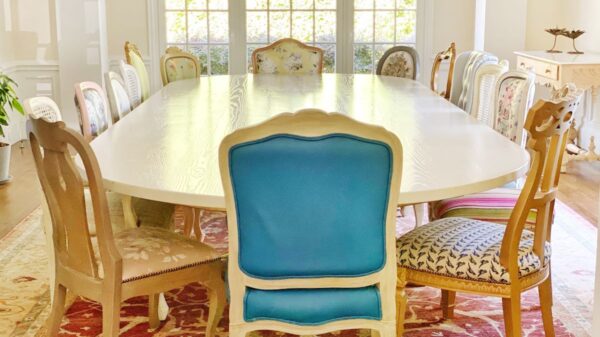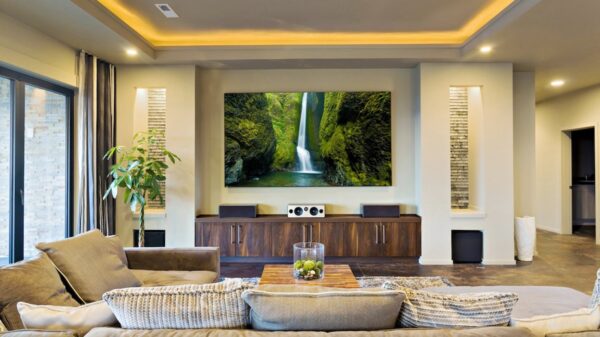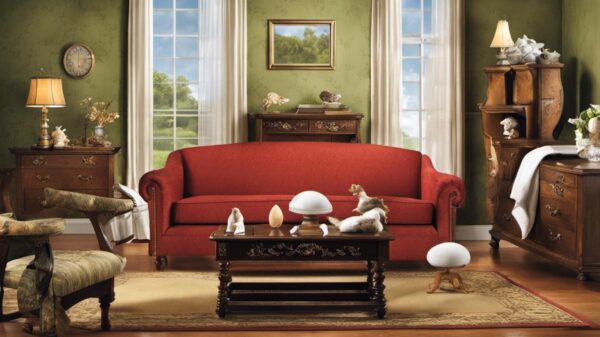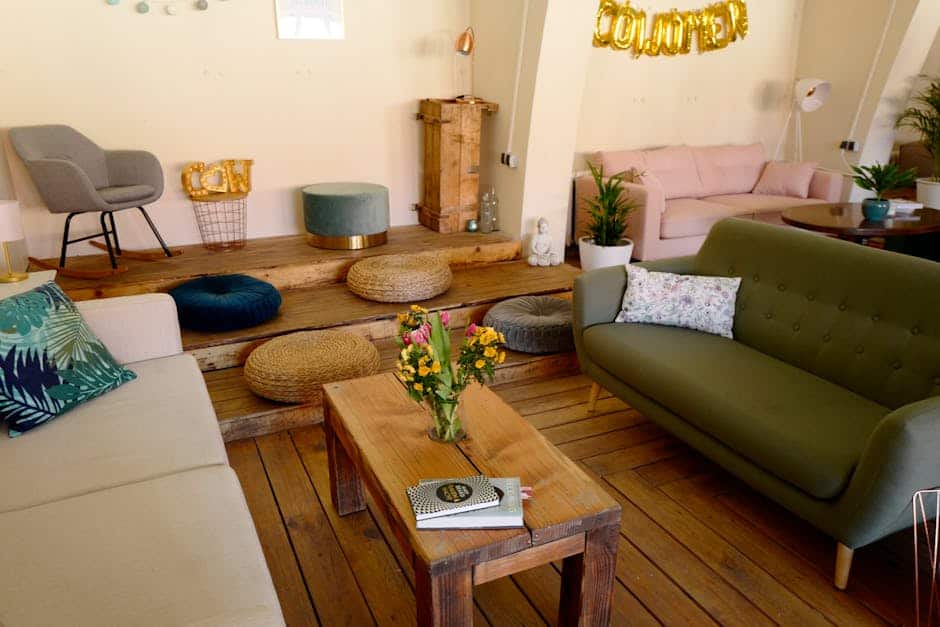1. Multifunctional Furniture
Choose furniture that works double duty. Pieces like a sofa bed, or a coffee table with built-in storage, offer more functionality without occupying extra space. This saves room while keeping your apartment clutter-free and organized.
Nesting tables can be easily moved and stored according to needs. They work perfectly for small gatherings or casual evening teas and can be tucked away when not in use.
A convertible desk that can fold up against the wall when not in use provides a workspace when you need one without sacrificing permanent floor space. This adaptability is particularly useful in compact living areas.
An ottoman with storage inside is ideal for small living rooms. These pieces provide a spot to rest your feet, extra seating when you have guests, and ample space inside for storing everything from blankets to books.
Invest in a tall, slender bookcase. It maximizes vertical space, which is often underutilized in small apartments. Use baskets or boxes on the shelves to neatly organize items and maintain a tidy look.
A wall-mounted drop-leaf table can be a lifesaver in a tiny kitchen. Fold it down when not in use to maintain open space, and lift it up quickly for an easy dining or additional prep area.
A bed with built-in drawers underneath provides discreet storage for clothing, bedding, or out-of-season items, helping keep your living space uncluttered.
Selecting the right furniture involves style and maximum functionality, especially when space is at a premium. Each piece should offer additional hidden benefits while complementing your personal living environment.
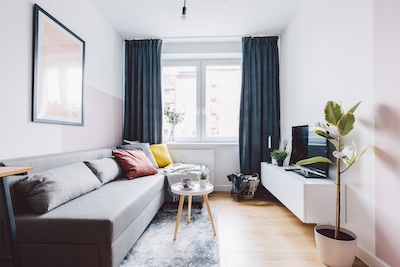
2. Light and Neutral Hues
In small apartment styling, light and neutral hues act as visual enhancers, expanding the perceived space. Soft whites, gentle grays, and soothing pastels brighten a room and reflect natural light, giving the illusion of a more spacious interior.
Optimize these tones by extending them to your furnishings and textiles. An off-white or pale gray sofa, rugs in muted tones, and curtains in breezy fabrics maintain a cohesive look while contributing to the overall lightness of the space.
By embracing light-hued walls you offer an unobtrusive backdrop, ideal for personal touches. Set brighter-colored accents or richly textured decor pieces against these neutral canvases to introduce character without overwhelming the senses. Items such as vibrant throw pillows, a boldly patterned ottoman, or colorful artwork add dimension and personal flair.
Investing in multiple light sources can further complement your pale-hued decor. Placement of lamps strategically around your room generates a soft glow, enhancing the expansive feeling of night or day. The curated light play augments the airy ambiance, ushering in a brightened aesthetic that makes small spaces feel more open.
Leveraging light and neutral hues creates aesthetic space. The calm induced by a visually uncluttered environment refreshes the mind. Enhanced with layered lighting and colorful accents, your small apartment becomes a haven reflecting your unique tastes and personality.
3. Mirror Magic
Harness the transformative power of mirrors to make a dramatic difference in the perceived size of your small apartment. Mirrors reflect light and depth, extending visual boundaries beyond the limitation of walls. Positioned strategically, mirrors can reflect daylight and artificial lighting, instantly making any room feel lighter and larger.
Placing a large mirror directly opposite a window bounces natural light throughout the space and offers a pleasing symmetry that draws the eye, giving the illusion of an additional window. Even in rooms with limited windows, mirrors can act as a visual expansion.
When incorporating mirrors into your decor, think beyond mere functionality. A beautifully framed mirror serves as a piece of art in its own right, adding a touch of elegance and personality to your home. Experiment with different shapes and frames to inject character or keep it understated with a minimalist design that complements a modern aesthetic.
For those who like the dramatic, a mirrored wall, or an assembly of various-sized mirrors on a single wall, could elevate the aesthetics substantially. This approach doubles the visual space and becomes a central feature of your decor.
Mirror placement can be strategic and playful:
- Angle a mirror near your dining area to reflect an elegant light fixture or artwork.
- Consider mirrored furniture such as a coffee table or end tables—it’s an unconventional way to boost light while maintaining functionality.
Through creative placement and thoughtful design choices, utilizing mirrors in your small apartment optimizes light and space and enriches the room’s stylistic expression—turning functional needs into decor centerpieces.
4. Vertical Storage Solutions
In the quest to declutter and optimize living space in small apartments, vertical storage solutions make full use of available height and clear valuable floor space, contributing to a less congested, more organized home environment.
Floating shelves hang on the wall and provide a platform for books, plants, art pieces, and personal treasures without sacrificing any floor real estate. They are perfect for arranging daily essentials and decorative items in a way that is accessible yet out of the way. Their versatility is unmatched, whether in the kitchen for spices and cookbooks, or in the living area for decorative elements.
For those who treasure a literary collection or love displaying an array of home decor items, investing in a tall, slender bookcase is the way to go.
These types of bookcases reach the ceiling, drawing the eye up and making the ceilings appear loftier. The slim profile of these bookcases means they can slip into narrow spaces, utilizing areas that might otherwise remain barren.
Configuring these shelves in a layered style, perhaps staggering their placement or utilizing varying lengths across a focal wall, provides storage and a visually captivating display. It encourages decorative storytelling, where each tier or nook can represent a different facet of your personal style.
Secure a climbing vine or a few trailing plants on the topmost shelves of your bookcases or floating shelves for a touch of green that infuses life into any corner. This beautifies the area and enhances air quality.1
With careful selection and strategic placement, vertical storage options elevate the look and functionality of your small apartment, ensuring every square inch works hard—both decoratively and practically.
5. Convertible and Extendable Pieces
Convertible and extendable furniture in a small apartment adapts to your daily needs while occupying minimal space. Choosing furniture that serves multiple purposes or can change size can help you make every square inch count, especially when entertaining guests or adapting day-to-day activities in a tight space.
Consider an extendable dining table. Often sleek in design, these tables stay compact for day-to-day use. When it’s time to host a dinner or work on a big project, they expand to accommodate additional guests or space for spreading out paperwork and supplies.
This versatile functionality ensures that your living area remains adaptable without perpetually consuming valuable floor space.
Opt for a fold-out desk that can be tucked away when your workday ends. These desks are perfect for small living areas where there might not be room for a permanent home office setup. A fold-out desk can transform part of your living room into a temporary workspace, allowing you to maintain a separate living area.
Convertible sofas provide chic, comfortable seating by day and transform into a bed by night. This dual function is particularly beneficial in studio apartments where space for extra furniture is limited. Look for models with built-in storage to increase your space-saving capabilities.
Bench seating with hidden compartments, whether placed in an entryway or used as additional seating at your dining table, offers ample storage space for items like linens, seasonal decor, or electronics. This keeps your living environment neat and clutter-free.
Lift-top coffee tables elevate for those times you prefer to dine or work from the couch but revert to standard coffee table height when relaxation is the only thing on your agenda. Some designs also integrate hidden storage compartments that are perfect for stashing away books, remotes, or craft supplies.
Each of these multifunctional pieces exemplifies modern furniture design, blending functionality with style while addressing the common constraints of small-scale living. Adopting convertible and extendable furniture pieces ensures that no matter the size of your home, you never have to compromise on comfort or functionality.
6. Declutter with Hidden Storage
In the world of small apartments, hidden storage is practically essential. These sneaky storage solutions help maintain calm in tight quarters by keeping your living areas tidy and spacious. The beauty lies in their ability to prevent clutter without sacrificing design or style.
Begin with the ever-trusty ottoman that doubles as a storage haven. Think of it as your secret stash spot for cozy throws, a collection of magazines, or those yoga mats that never seem to find a home. This dual-purpose furnishing provides a comfy resting spot for feet and acts as additional seating during movie nights or friendly gatherings.
Beds equipped with built-in drawers offer space for your extra linens, sports gear, or off-season clothing. This clever use of the often-wasted space under your bed’s mattress frees up closet space and makes sorting through seasonal attire a breeze. For those who find drawer beds a bit too bulky, hydraulic lift beds present another stylish opportunity. With a gentle lift, these offer ample space perfect for stowing away nearly anything you want out of sight.
The clean lines of a lift-top coffee table adapt quickly from a simple, stylish coffee table into an impromptu office desk or dining area while concealing your clutter inside. Whether it’s remote controls, gaming essentials, or craft supplies, everything finds its respective nook.
On the more traditional side, consider vintage trunks or decorative crates strategically placed to accentuate your interior decor. These gems offer character and charm while housing everything from seasonal decorations to nostalgic keepsakes, ensuring that your memorabilia stays together and out of the way.
Floating wall-mounted units extend the concept of hidden storage vertically! Whether used as a chic bedside alternative in your sleeping area or as a sleek component of your living room’s entertainment system, these units utilize empty air space effectively—keeping daily essentials handy but out of view when not in use.
By cleverly employing furniture with built-in storage, you maximize your available square footage and reduce visual disorder. The result? A clutter-free atmosphere that feels roomier and well-composed, ready to impress visitors or to allow you to breathe easier—a little more organized and a little more spacious.
7. Light and Airy Window Treatments
Embracing natural light can transform the feel of a small space, making it feel wider and more welcoming. Installing light and sheer curtains is a great way to balance privacy and breathable, sunlit spaces.
These types of window treatments allow sunlight to filter through gently, illuminating the colors and textures of your home, and creating a more expansive feel.
Opt for curtains in soft hues like creamy white, faint gray, or subtle pastels to enhance the sensation of openness and airiness. Textiles that catch the breeze add a dynamic element to your space, as the soft movement of the fabric can breathe life into a static room. These lightweight curtains sway gracefully even in the slightest draft, adding a dose of tranquility and motion that is calming.
For those with more eclectic tastes, consider layering different types of sheers with varying opacities. This approach not only plays with light and shadow, crafting a layered aesthetic but also offers flexibility in controlling privacy and natural illumination according to different times of the day or your personal preference.
Using extendable or telescopic curtain rods that span slightly beyond the window frame can trick the eye into perceiving the windows—and by extension, the room—as larger than they truly are. This effect can be amplified further by securing the curtain panels back with stylish ties or hooks during the day to allow maximum daylight to pour in.
Integrating mirrors close to your window treatments is another smart tactic—the reflected light can give an illusion of additional windows and a brighter space. By framing your softly draped curtains with mirrored accents or reflective decor, you can create an aesthetically pleasing and luminous space that feels larger.
Curtains aren’t just for windows! Use these light sheers as clever partitions in studio apartments—dividing living areas without the heaviness or visual bulk of solid doors or screens. This keeps the footprint light and adaptable, ready to transform according to how you use your space throughout your daily routine.
By selecting the right window treatments, you can craft a luminous canvas where the interplay of light and fabric can paint your small spaces in broad, airy strokes—turning mere walls and windows into an inspiring panorama of light, texture, and flow.
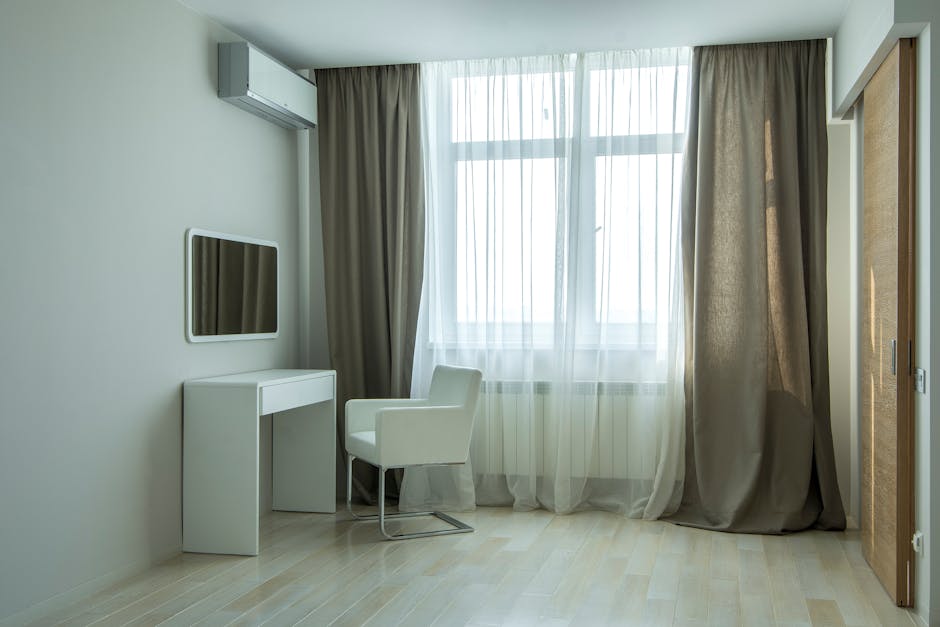
8. Rugs to Define Spaces
Area rugs serve not solely as decor, but also as clever definers of spaces in compact living environments. They bring a room to life while adding warmth, comfort, and a dash of personality to any setting.
An area rug perfectly downplays the limitations of a smaller layout by inviting eyes to follow its contours, crafting illusions of boundary and extension within your space. Here’s how to use them strategically:
- Visual Division: With space at a premium, employ rugs as softer, flexible partitions. For instance, in an open-plan studio, a plushy wool rug can visually distinguish the lounge area from the rest of the home. Similarly, a contemporary geometric rug can indicate the dining area, giving it personality and livelihood.
- Color Coordinate: Use the power of color in rugs to enhance or complement furnishings. For a small space to appear unified, the rug should harmonize with nearby textiles and large decor elements. For example, a cool-colored rug under a couch can lift the hues of throw pillows or other upholstery in the room, heightening the style through coherence.
- Size Matters: The adage, “Bigger is better” is often accurate when choosing rugs for small apartments. A larger rug tethers different components together, such as a dining table and surrounding chairs, making the ensemble feel rooted instead of spontaneously placed. Keep in mind, though, the rug should leave a few inches of bare floor around the edges—it’s crucial that it does not look squeezed into an area as this can make the space appear cluttered.
- Texture Tale: Adding a rug brings colors and textures into a living space. In smaller surroundings, textures play a vital role in elevating flat sections into vibrant aspects of home life. The contrast between a soft rug and wooden floors or sleek furniture pieces can add depth and tactile appeal. From chunky braids that are gentle to the touch to woven Dhurries that look classic and are easy to maintain, each motif brings its rhythmic narrative to your floor.
- Layering Love: For an additional notch in decorative flair, consider overlapping rugs. This boosts aesthetic charm and layers additional texture and contrast that make a small space lively and engaging. Try overlapping a smaller, brightly colored patterned rug over a larger neutral one for an eclectic, bold statement, or mix two complementing styles for a more subtle yet textured look.
By carefully choosing textures, colors, and strategic arrangement, an area rug decorates and enhances your small apartment’s spatial aesthetics, encouraging every tiny parameter to look both well-appointed and generously spacious. Let your floor speak volumes of your style while quietly expanding the visual expanse of your living area.
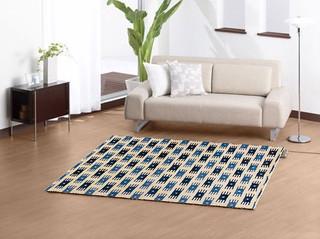
9. Sleek, Minimalist Lines
In the ballet of small space furnishing, sleek, minimalist designs take center stage, bringing an ethos of simplicity that magnifies roominess and underscores elegance.
When decorating small apartment living spaces, bulky intricacies can muddy visual and physical accessibility; enter the graceful clarity of minimalist aesthetics—where each item embodies both functionality and understated beauty.
Furniture designed with clean, straight lines lends a streamlined silhouette that speaks in whispers not shouts, crafting an air of tranquility through its lack of clutter.
These items, often characterized by metallic finishes or neutral colors, such as stark whites, charcoal blacks, or muted grays, enhance the feel of expansiveness in a small abode. A practical yet subtle geometric coffee table, a slim console, or sleek shelving unhindered by ornate details can elevate the sense of serenity.
The absence of intricate patterns or cumbersome features in minimalist design also creates a lens through which natural and artificial lighting can traverse more freely across your space. This is important in areas where every bit of light counts double in sensory impact.
Here, even the smallest echo of brightness becomes a courier, moving unhindered, helping to enlarge visual fields—a testament to minimalist furnishings’ ability to amplify light.
Beyond the aesthetic, the practicality of minimalist pieces often lies in their versatility. Modular setups flaunting neat, defined edges can be rearranged to suit diverse needs or multifunctional interiors without fighting for space dominance.
Each piece is crafted purposefully—simple yet robust in function—whether as silent sentinels holding daily essentials or transformable assets adapting to pressing spatial demands.
Embracing minimalist habits extends from choosing straight-edged furniture to organizing principles and ornamental fields. Opt for decor that skews toward the minimal, like singular art pieces that grab attention without overtaking entire walls or versatile accents that prioritize functionality matched with their subtle aesthetic virtue.
By meticulously furnishing with clean, straight lines and embracing minimalist engagements as a lifestyle choice, small spaces don’t just receive a decorative facelift; they undergo a transformative rationalization into stylish oases brimming with poise and inviting symmetry.
10. Incorporating Reflective and Metallic Surfaces
In the charming concerto of small space elegance, the clever use of reflective and metallic surfaces plays a luminous refrain that naturally expands and enlightens your living quarters.
By wisely incorporating these shiny allies, your home doesn’t just radiate stylish vibes—it smartly magnifies them. Here’s how to strategically embrace these reflective enhancements to make your compact sanctuary seem more expansive.
Begin by considering the strategic placement of mirrors—not merely for aesthetic appeal but for their capabilities to multiply light. A well-placed mirror, for instance, directly across from a window, harnesses daylight and reroutes it, filling the room with natural illumination and visual expansion.
Even in areas lacking large windows, a generous mirror installation can mimic the spaciousness more windows might provide.
Metallic surfaces, meanwhile, scintillate under sunbeams or artificial light, effectively dispersing cheer throughout your space. Glimmering nuances from an antique brass table lamp or the polished gleam of a stainless-steel chair frame can counter corners of shadows with speckles of light. It’s a symphony of reflections that turns ordinary rooms into sophisticated galleries.
Metallic decor doesn’t have to be large scale; even small touches like gold picture frames, a metallic vase or candle holders can introduce enough sleek elegance without overwhelming. Incorporating such accents on tables or shelves makes sure they catch the light, bouncing it playfully within the confines of your cozy abode.
Decorative items crafted from reflective materials further symbolize thoughtful selections meant to adorn while amplifying the perception of spaciousness. Think glossy, lacquered trays that reflect the tableau of your living room from the day’s coffee cups to evening’s lounging glass of wine, magnifying both taste and space.
In spaces where light is premium but scope for large swathes of shiny metals may look overdone, focus on finishes and fittings where a bit of shine is expected yet uplifts the overall theme—metallic knobs on drawers, faucets in bathrooms, or simple door handles. Each serves a dual purpose, enhancing functionality with sporadic spells of radiance.
Reflectivity can overflow into softer decor domains too—cushions embroidered with metallic threads or delicate glass decor items. Such accessories work in cohesion with harsher metals providing a layered reflective quality that’s not ubiquitous yet every bit as effective in visually scaling dimensions.
Consider integrating furniture with mirrored panels or facets. A console or dresser flaunting mirrored drawers or doors seamlessly blends its practicality while reflecting further fragments of your room, offering a dual-role ensemble consciously deployed for endless-style successions.
Creating reflections doesn’t rest merely in acknowledging them as additions but nurturing them to function as intrinsic co-stars in the small-area styling narrative.
The subtlety with which they are threaded through day-to-day life fuses ordinary elements into extraordinary exhibition episodes—spaces are not walls and furniture, but vivacious art supplies on a dynamic platform where you lead as director.
Ultimately, engaging with reflective and metallic décor offers an immediate expansion to the space they inhabit and to the creative depth of your range as a curator within your living spaces—allowing for functional artistry that matches rhythmic residential rhapsodies with reveling rays befitting your everyday scene stage.
Choosing Small Apartment Furniture for Your Home
Adopting multifunctional furniture is perhaps the most impactful strategy for those residing in compact spaces. This choice not only saves space but also adds a layer of convenience and adaptability to everyday living, proving that even the smallest homes can be both stylish and functional.


